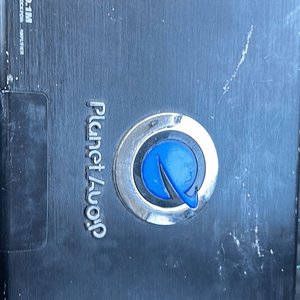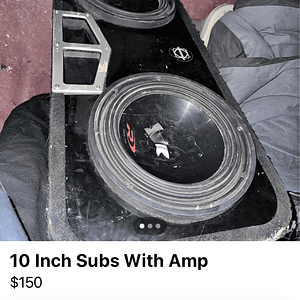dragon.breath 10+ year member
Senior VIP Member
this free e-book has been floating around the net for some time now. i thought it might help some of the noobs.
10 Big Bass Secrets
I have been asked probably just about every bass
question in the book. I'm guessing you have questions
too. Here I try to answer them.
The crazy thing about bass, is that sometimes you hit,
and sometimes you miss. I have seen many car stereo's
that were put together with barely any knowledge, hit
real hard. I've also seen a lot of money spent with poor
results.
This book will help you hit, every time.
I write this book today because I want you to enjoy
your stereo system without headaches. I want yours to
be as good or better than the guy winning that
competition. I want you to be able to help your friends
with their systems and I want you to go into the car
stereo store armed with knowledge.
It has been almost 25 years since I was bit by the
stereo bug and I have learned a lot since I was a kid.
Here is some very important stuff that could take some
time to discover.
I've done it all, set cars on fire, blown amps, woofers,
you name it. I've torn my moms car apart and put it
back together rigged with speakers. I've won
competitions, judged competitions, SQ and SPL alike.
Having the biggest bass is more complex than buying
the heaviest or largest subwoofer, more complex than
buying the longest amp, or the one that says 5000
watts across it. It's more complicated than any one or
two of these things.
Now that you possess these 10 secrets, your chances of
a loud, efficient, reliable and clean subwoofer system
are greatly improved.
Each of the ten chapters is designed to give you the
competitive edge. These industry secrets are the tricks
used by the pro's and utilized by manufactures to
produce the loudest, most accurate, efficient and
reliable systems of today. In no particular order of
importance, here they are.
#10 . ORIENTATION AND PHASE
A subwoofer system will create sound pressure. This
actual air pressure needs to make it to your ears or
microphone in an efficient manner. It will not make it
there efficiently if you allow this pressure to escape,
diffuse, or become out of phase. So, first lets look at
your enclosure. Where are your woofers mounted?
Secret:
Place all the woofers and ports on the same plane for
maximum output. Aim this plane rearward. This is the
best way to get loud unless your subwoofers are on a
wall, completely sealing them on all four walls of your
car.
Ok next, play with distance from rear of vehicle. You
can change the output of your enclosure at different
frequencies by playing with this. If you like flat
response, your gonna want your enclosure most
rearward with room for excursion. This setup is ideal
because, it allows the pressure to find its way to your
ears at about the same time. If your subwoofer
enclosure had woofers on two different planes, the
sound pressure would reach your ears at different
times. Sound travels at a predetermined speed. If one
of your woofers is further away from you its pressure
will arrive at a different time creating a loss in
pressure. Imagine a simultaneous punch in the chest
from two pro boxers. That's woofers on the same
plane. Imagine a left jab from a pro boxer as I pull you
back, this is two or more woofers on different planes.
The first woofer may actually reduce the impact of the
second woofer and be weaker than one woofer alone.
#9 . POWER VS. CONE AREA
Here I am giving away the secrets about amplifier
power vs. size/number of woofers. This Chapter will be
short and sweet. Here I will give you the secrets to help
you decide to get more woofers or more amplifier
power.
Secret:
Subwoofers are more efficient than amplifiers.
This is quite funny as I am comparing apples to
oranges, but you will understand in a moment.
Woofers are more efficient than amps and this is why.
When you double your amplifier power on a woofer,
you will gain a maximum of 3 decibels. When you
double your woofer count, you will gain 6 decibels.
Why would I say a maximum of 3 decibels from a
doubling of amp power? Because just because you
feed a subwoofer more power, doesn't mean it can
effectively turn it into sound. A subwoofer can only
turn power into sound pressure in a linear fashion up
to a point, where power compression sets in. This is
caused by suspension resistance and loss of magnetic
strength at extreme excursions. Contrarily, you will
always gain 6 decibels by doubling your subwoofer
count. Keep in mind, you will need to give every
subwoofer its proper enclosure. You cannot simply add
more woofers to existing enclosure volume.
Here are examples of the formula...
I have two twelves + 100 watts = 120 decibels
I have four twelves + 100 watts = 126 decibels
I have two twelves + 200 watts = 123 decibels
I have four twelves + 200 watts = 129 decibels
I have four twelves + 400 watts = 132 decibels
So, what we have discovered is, if you have the space,
add subwoofers instead of more amplifier power.
10 Big Bass Secrets
I have been asked probably just about every bass
question in the book. I'm guessing you have questions
too. Here I try to answer them.
The crazy thing about bass, is that sometimes you hit,
and sometimes you miss. I have seen many car stereo's
that were put together with barely any knowledge, hit
real hard. I've also seen a lot of money spent with poor
results.
This book will help you hit, every time.
I write this book today because I want you to enjoy
your stereo system without headaches. I want yours to
be as good or better than the guy winning that
competition. I want you to be able to help your friends
with their systems and I want you to go into the car
stereo store armed with knowledge.
It has been almost 25 years since I was bit by the
stereo bug and I have learned a lot since I was a kid.
Here is some very important stuff that could take some
time to discover.
I've done it all, set cars on fire, blown amps, woofers,
you name it. I've torn my moms car apart and put it
back together rigged with speakers. I've won
competitions, judged competitions, SQ and SPL alike.
Having the biggest bass is more complex than buying
the heaviest or largest subwoofer, more complex than
buying the longest amp, or the one that says 5000
watts across it. It's more complicated than any one or
two of these things.
Now that you possess these 10 secrets, your chances of
a loud, efficient, reliable and clean subwoofer system
are greatly improved.
Each of the ten chapters is designed to give you the
competitive edge. These industry secrets are the tricks
used by the pro's and utilized by manufactures to
produce the loudest, most accurate, efficient and
reliable systems of today. In no particular order of
importance, here they are.
#10 . ORIENTATION AND PHASE
A subwoofer system will create sound pressure. This
actual air pressure needs to make it to your ears or
microphone in an efficient manner. It will not make it
there efficiently if you allow this pressure to escape,
diffuse, or become out of phase. So, first lets look at
your enclosure. Where are your woofers mounted?
Secret:
Place all the woofers and ports on the same plane for
maximum output. Aim this plane rearward. This is the
best way to get loud unless your subwoofers are on a
wall, completely sealing them on all four walls of your
car.
Ok next, play with distance from rear of vehicle. You
can change the output of your enclosure at different
frequencies by playing with this. If you like flat
response, your gonna want your enclosure most
rearward with room for excursion. This setup is ideal
because, it allows the pressure to find its way to your
ears at about the same time. If your subwoofer
enclosure had woofers on two different planes, the
sound pressure would reach your ears at different
times. Sound travels at a predetermined speed. If one
of your woofers is further away from you its pressure
will arrive at a different time creating a loss in
pressure. Imagine a simultaneous punch in the chest
from two pro boxers. That's woofers on the same
plane. Imagine a left jab from a pro boxer as I pull you
back, this is two or more woofers on different planes.
The first woofer may actually reduce the impact of the
second woofer and be weaker than one woofer alone.
#9 . POWER VS. CONE AREA
Here I am giving away the secrets about amplifier
power vs. size/number of woofers. This Chapter will be
short and sweet. Here I will give you the secrets to help
you decide to get more woofers or more amplifier
power.
Secret:
Subwoofers are more efficient than amplifiers.
This is quite funny as I am comparing apples to
oranges, but you will understand in a moment.
Woofers are more efficient than amps and this is why.
When you double your amplifier power on a woofer,
you will gain a maximum of 3 decibels. When you
double your woofer count, you will gain 6 decibels.
Why would I say a maximum of 3 decibels from a
doubling of amp power? Because just because you
feed a subwoofer more power, doesn't mean it can
effectively turn it into sound. A subwoofer can only
turn power into sound pressure in a linear fashion up
to a point, where power compression sets in. This is
caused by suspension resistance and loss of magnetic
strength at extreme excursions. Contrarily, you will
always gain 6 decibels by doubling your subwoofer
count. Keep in mind, you will need to give every
subwoofer its proper enclosure. You cannot simply add
more woofers to existing enclosure volume.
Here are examples of the formula...
I have two twelves + 100 watts = 120 decibels
I have four twelves + 100 watts = 126 decibels
I have two twelves + 200 watts = 123 decibels
I have four twelves + 200 watts = 129 decibels
I have four twelves + 400 watts = 132 decibels
So, what we have discovered is, if you have the space,
add subwoofers instead of more amplifier power.


